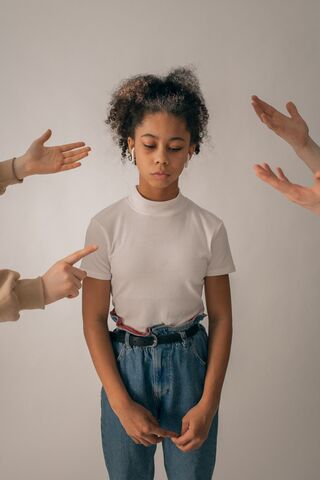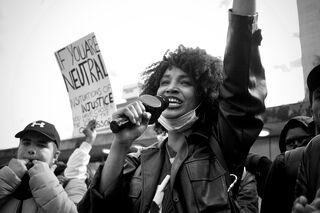Identity
The Magic of Black Girls
#BlackGirlMagic is a space to reclaim identity and the story of Black girlhood.
Posted April 29, 2022 Reviewed by Ekua Hagan
Key points
- Often "othered" or deemed as "invisible" by society, Black girls build identities that resist and reject structures of racism and sexism.
- #BlackGirlMagic is a platform for reclaiming Black girlhood and enhancing Black girls' development.
- In a study of 60 teenage Black girls, 80% attested to the sense of empowerment and connection created by #BlackGirlMagic.
Who am I? How do other people see me? These are the questions that define identity development—the process through which young people form a clear and meaningful sense of who they are and where they are headed (Erikson, 1968). Having a positive, affirming identity is foundational to health and wellbeing, especially during the teenage years (Butler-Barnes et al., 2018). Importantly, our identities are in conversation with, and often in resistance to, society’s images of and stories about who we are "supposed" to be (Rogers, 2018).
In our research, focusing on the teenage years as a key period of development for Black girls, we asked Black girls what being a Black girl means to them. Cadence, one of the 12th-graders in our study, explained it like this:
"Well, as African-American and a female, [being a girl means] loving yourself. Um, I feel like self-love is sometimes not taught to females, like we’re supposed to bow down to males, but girl, no; no, we’re not going to do that."—Cadence, 12th grade, African-American female

For Cadence, and many of the Black girls we spoke to, being a Black girl means negotiating a racial and gender hierarchy that positions Blackness and femaleness as less than—and at the same time rejecting that oppressive system: "Girl no; no, we're not doing that."
Sociology theorist Charles Cooley described identity as the "looking glass self," arguing that we learn who we are from the images and messages reflected on us by those around us, including society broadly. We need not look far to see that this poses a real problem for Black girls in this country. Society's images and messages about Black girls and women are persistently harmful, narrow, and dehumanizing. Dr. Moya Bailey defined “misogynoir” as the specified anti-Black and misogynic representations of Black females, which are perpetrated across social media, in schools and workplaces, and in larger societal systems.
In response to these toxic narratives, CaShawn Thompson created the hashtag #BlackGirlMagic as an intentional space to highlight the success and beauty of Black females. Since then, there have been whole Twitter feeds and Instagram pages dedicated to celebrating Black girls and women, #BlackGirlMagic merchandise to purchase, and Essence magazine spreads, including an interview with President Barack Obama and prima ballerina Misty Copeland about Black girl magic and why it matters.

As developmental psychologists studying the lives and experiences of adolescent Black girls, we asked: What, if anything, does #BlackGirlMagic mean to Black girls? Does it influence their identities? Can a social media narrative like #BlackGirlMagic protect against the cascade of harmful stereotypes and tropes that young Black girls face?
We asked 60 teenage Black girls about the meaning and significance of "Black girl magic," and over 80% told us about the power of its affirmation and empowerment, the sense of connection and sisterhood. More than surface-level positivity, however, many Black girls spoke about why "Black girl magic" exists—that is, the historical context of oppression and persistence of stereotypes and discrimination they see and face in their own lives. As Aaliyah, an 11th-grade Black girl in our study, explained: “Black girl magic means embracing yourself as a Black female...and not letting stereotypes dictate how you look at yourself.”
Rather than the “looking glass self," we hear Black girls rejecting and replacing society’s toxic reflections by embracing and affirming their Black girlness. For the girls in our study, #BlackGirlMagic was a space for them to resist the negative stereotypes and reclaim their identity and the story about Black girlhood:
“Black Girl Magic to me means Black girls are trying to get their rights back because we are the ones who have the most stereotypes in the world. So, we have to fight those stereotypes and show the world who us Black girls are—really are.”—Brielle, 11th grade, Black girl

In this way, #BlackGirlMagic is not simply a message "for" Black girls but a message "from" Black girls, it is a platform to proclaim their collective knowledge about who they already know they are. This resonates with W.E.B. DuBois’ “double consciousness” and bell hooks' "oppositional gaze"—the recognition that Black people, because of white supremacy and anti-Black hatred, have always had to negotiate—and resist—white society’s racist reflections of Blackness. It is a constant negotiation—a necessary skill for Black youth to thrive. And this is precisely what we hear from Black girls: resisting, reclaiming, and retelling their own stories.
Black girls know what society thinks about them. But they also know what they think about themselves—their own identities and possibilities and their potential and power, their humanity. Such knowledge is a necessity for Black girls to construct who they want to be in a society where they are often "othered" or deemed as "invisible."
Black girls are not superhuman but they are steadfastly human in a society that persistently obscures their humanity—and that is magical.
This blog was written in collaboration with my colleague, Dr. Sheretta Butler-Barnes, an associate professor of social work at Washington University in St. Louis.
References
Butler‐Barnes, S. T., Leath, S., Williams, A., Byrd, C., Carter, R., & Chavous, T. M. (2018). Promoting resilience among African American girls: Racial identity as a protective factor. Child development, 89(6), https://doi.org/10.1111/cdev.12995
Erikson, E. H. (1968). Identity: Youth and crisis (No. 7). WW Norton & company.
Rogers, L. O. (2018). Who am I, who are we? Erikson and a transactional approach to identity research. Identity, 18(4), 284-294. https://doi.org/10.1080/15283488.2018.1523728
Rogers, L. O., Butler Barnes, S., Sahaguian, L., Padilla, D., & Minor, I. (2021). # BlackGirlMagic: Using multiple data sources to learn about Black adolescent girls’ identities, intersectionality, and media socialization. Journal of Social Issues, 77(4), 1282-1304. https://spssi.onlinelibrary.wiley.com/doi/full/10.1111/josi.12483
hooks, b. (1992). Black Looks: Race and Representation. Boston: South End Press




